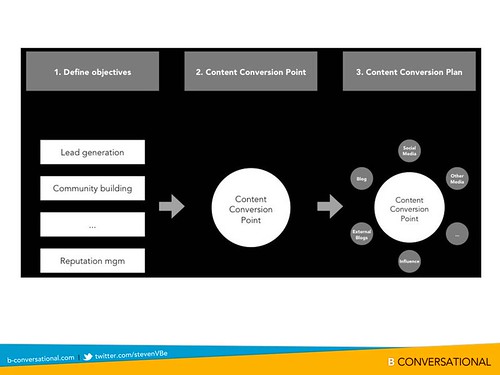How to write a âcontent conversionâ plan?

Last week, the paper ‘four steps to a more effective social media usage’ was published on my blog. The first step in this approach is to write a ‘content conversion’ plan. In this post, the focus is on this first step.
From stand-alone social silo’s to an integrated approach
Most managers think of social media channels as stand-alone silos. Content is spread through each of these channels without a clear plan on how to reach business objectives. The truth is that all online channels are interrelated. Consumers can even be routed from channel A to channel B. The challenge is to design a plan to optimize the impact of your social media investments.
A content-conversion plan includes every touch point where a (potential) customer can come into contact with your content. Then you need to determine at which of these touch points conversion to your objectives (reputation management, community building, lead generation…) is likely to occur. All other social channels support traffic generation towards these conversion points. Instead of having a set of silo channels, this creates a set of interrelated online channels.
For example, the converting touch point might be the corporate website or blog. A corporate blog can be the touch point that leads people from the content area to the sales area. Your other social media accounts ensure that sufficient traffic is channeled to the blog every day.
For companies working in the knowledge sector, SlideShare can serve as a useful converting touch point. SlideShare is a social network site where people can share presentations (PowerPoint, etc.). This is the ideal place to showcase what you can do and what you have to offer. On this platform, it is easy to directly convert a reader into a sales lead. In case your key objective is community building, your Facebook page may be the best content-conversion point. When mapping out your conversion touch-point plan, define the trigger for each touch point that makes it possible to move on to the next. Furthermore, try to keep the lines as short as possible. The more steps are necessary in order to reach the touch point where your business goals are realized, the harder it is to achieve high conversion rates.
Questions to ask in building your content-conversion plan:
1. What is the key objective of our content marketing?
Some companies focus on creating brand awareness and others on becoming an expert or on creating business leads. Depending on your objective, there are several content-conversion points to choose from.
2. Which online touch point provides the best odds of reaching this objective?
Define the best place on the web to reach your objectives. Below you will find several examples of content-conversion points. Since so much depends on the context, the contents of this table should be viewed as examples and not as the only possible outcome of the discussion.
|
Objective |
Touch Point |
Details |
| Create businessleads | Corporate blog | Link to contact details available so people will contact you for commercial information |
| Strengthen the emotional bond | Organize open and wide-ranging forms of customer collaboration to increase involvement | |
| Improve customer experience | Most complaints and questions come through Twitter, so we focus on this channel for an optimum customer service | |
| … | … | … |
3. Which channels can create traffic to the content conversion point?
Once you’ve determined your content conversion point, the challenge is to bring people there. All social media channels can be helpful in reaching this goal. In this phase, the tough part is being able to use your content intelligently. For instance, suppose you’ve launched a great YouTube video and you want to share it with your followers. If you have chosen your blog as the content conversion point, you should embed the video in the blog and share the link to the blog post that includes the video. Mention your blog and the URL in the description on YouTube. Also, don’t forget to mention the name and URL of your blog. Every time someone embeds your video on their blog, this helps increase the traffic to your blog. If one of your employees gives a presentation outside your company, put the name and URL on the last slide: “For more info about our company/subject of presentation check out our blog at …†Create relevant cross links to your conversion point e.g. in your Twitter profile background. The more roads lead to the conversion point, the better.
Download the full paper
This post zooms in on one aspect of the paper ‘increase the effectiveness of your social media channels in four steps’. If you would like to read the entire paper, you can download it here.
